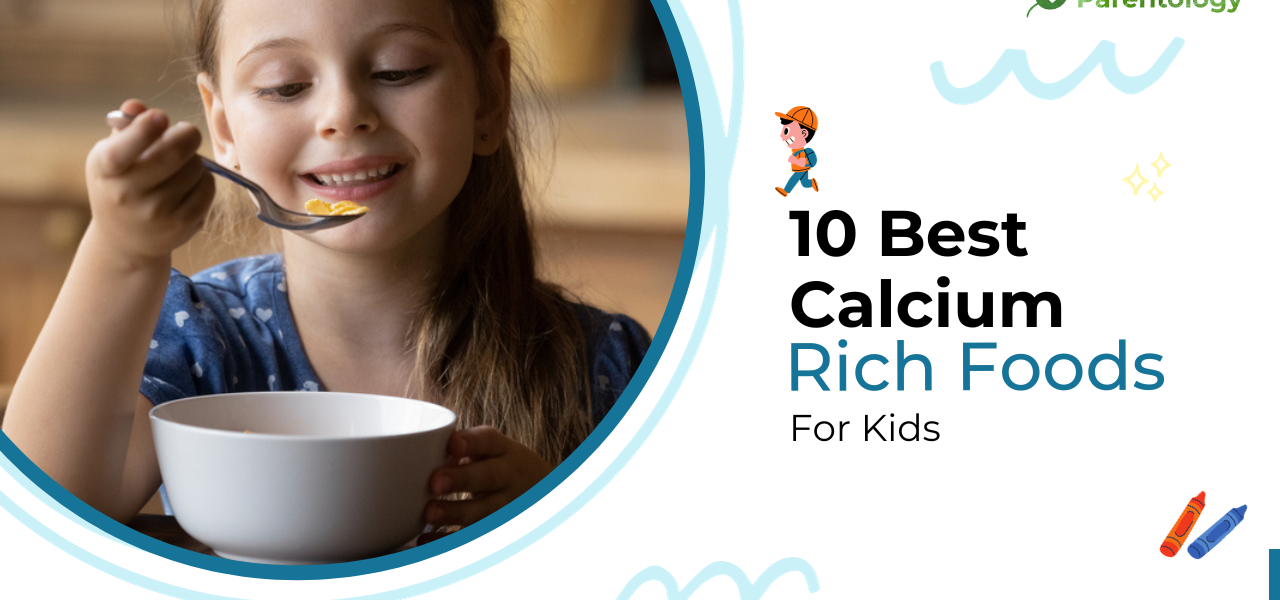10 Best Calcium-Rich Foods For Kids – Building Strong Bones
Calcium is vital for a child’s growth and development, contributing to strong bones and teeth. Including calcium-rich foods in a child’s diet is essential to ensure they meet their daily calcium needs. Let’s explore ten of the best sources of calcium for kids.
1. Dairy Products
Milk: A classic source of calcium, milk also contains vitamin D, crucial for calcium absorption.
Yogurt: High in calcium and probiotics, aiding digestion and supporting bone health.
Cheese: Offers calcium along with protein and other essential nutrients.
2. Leafy Greens
Spinach: Packed with calcium, spinach is a versatile addition to various meals.
Kale: Rich in calcium and other vitamins, ideal for salads or blended into smoothies.
3. Fortified Foods
Fortified Cereals: Certain breakfast cereals are fortified with calcium, making them a convenient and tasty option for kids.
Tofu: Tofu fortified with calcium is a plant-based alternative for calcium intake.
4. Fish with Edible Bones
Canned Salmon or Sardines: These fish varieties with soft, edible bones offer calcium and omega-3 fatty acids.
5. Nuts and Seeds
Almonds: A tasty snack high in calcium, perfect for on-the-go munching.
Chia Seeds: Versatile and packed with calcium, these seeds can be added to various dishes.
6. Beans and Legumes
White Beans: Rich in calcium and fiber, adding them to soups or salads boosts nutritional content.
Black-eyed Peas: Another excellent source of calcium, easy to incorporate into various recipes.
7. Oranges and Citrus Fruits
Oranges: Besides vitamin C, oranges provide calcium, promoting strong bones.
Figs: Dried figs contain decent amounts of calcium and make a sweet, healthy snack.
8. Broccoli
Broccoli: Not only a source of calcium but also contains vitamin K, essential for bone health.
9. Sesame Seeds
Tahini: Made from sesame seeds, tahini is a flavorful paste that can be used in dressings, dips, or spreads.
10. Amaranth
Amaranth: This ancient grain is a powerhouse of calcium and can be used in porridges or added to baked goods.
Dairy Products: Essential Calcium Sources
Milk, yogurt, and cheese are rich in calcium, offering a foundation for a child’s bone health. These dairy products also provide additional nutrients like protein and vitamin D, crucial for calcium absorption.
Tips for Incorporating Dairy: Try flavored yogurt as a dessert, use cheese in sandwiches or as toppings for dishes, and offer milk as a standalone beverage or in cereal.
Leafy Greens: Plant-Based Calcium
Spinach and kale are excellent plant-based sources of calcium. While spinach can be added to various meals, kale can be enjoyed in salads or blended into smoothies for a nutrient-packed drink.
Maximizing Leafy Greens: Mix spinach into pasta sauces or soups, and incorporate kale into salads or homemade pesto for added nutrients.
Fortified Foods: Added Calcium Boost
Fortified cereals and tofu are options with added calcium. These foods are convenient and can be an enjoyable part of a child’s breakfast or lunch.
Serving Ideas: Choose cereals with lower sugar content and experiment with tofu by incorporating it into stir-fries or blending it into dips.
Fish with Edible Bones: Uncommon Sources of Calcium
Canned salmon or sardines are unique sources of calcium due to their soft, edible bones. These fish varieties also provide omega-3 fatty acids, essential for overall health.
Incorporating Fish: Use canned salmon in salads or sandwiches and sardines in pasta dishes or as toppings for crackers.
Nuts, Seeds, and Legumes: Versatile Calcium Options
Almonds, chia seeds, white beans, and black-eyed peas are versatile sources of calcium. These foods offer a variety of flavors and can be incorporated into numerous dishes.
Ideas for Use: Sprinkle almonds on yogurt, incorporate chia seeds into smoothies, add white beans to soups, and use black-eyed peas in salads or stews.
Fruits and Vegetables: Sneak in Calcium
Oranges, figs, and broccoli might not be the first fruits or veggies that come to mind for calcium, but they contain decent amounts that can contribute to a child’s calcium intake.
Fun Ways to Include Them: Offer fresh oranges as a snack, dried figs for a sweet treat, and steamed broccoli as a side dish or in pasta dishes.
Sesame Seeds and Amaranth: Lesser-Known Calcium Sources
Tahini made from sesame seeds and amaranth, an ancient grain, are less common but potent sources of calcium, adding variety to a child’s diet.
Utilizing Sesame Seeds and Amaranth: Use tahini in salad dressings or dips, and incorporate amaranth into porridges or baked goods for added nutrients.
Importance of Calcium-Rich Foods for Growing Kids
Calcium plays a pivotal role in children’s growth and development, especially during their formative years. Adequate calcium intake is essential for:
- Building Strong Bones: Calcium contributes to the development of sturdy and healthy bones, ensuring proper skeletal growth.
- Teeth Development: Calcium also supports the formation and maintenance of strong teeth, promoting oral health.
- Muscle Function: Apart from bones, calcium is necessary for muscle contraction, nerve signaling, and overall cellular function.
Innovative Ways to Include Calcium-Rich Foods in Kids’ Diets
- Smoothie Blends: Create delicious and nutritious smoothies by blending leafy greens, fruits, yogurt, or fortified milk, offering a refreshing calcium-rich drink.
- Sneaky Veggie Additions: Incorporate finely chopped leafy greens or broccoli into pasta sauces, soups, or casseroles for a nutrient boost.
- Homemade Snacks: Make homemade snacks like energy bars or granola bites with calcium-rich nuts, seeds, and dried fruits.
- Interactive Meal Preparations: Involve kids in meal preparation by making yogurt parfaits with fruits and nuts or assembling DIY cheese and veggie skewers.
- Calcium-Boosted Breakfast: Serve fortified cereals with a side of calcium-fortified milk, offering a quick and nutritious morning meal.
Calcium Absorption Enhancers and Inhibitors
Understanding factors that affect calcium absorption can aid in optimizing its intake:
- Enhancers: Vitamin D promotes calcium absorption, so ensure kids get adequate sunlight exposure or include vitamin D-rich foods like fortified cereals, eggs, or fatty fish.
- Inhibitors: Some substances, like excessive caffeine or high-sodium diets, can hinder calcium absorption, so moderation is key.
Calcium Requirements for Kids and Meeting Daily Needs
The recommended calcium intake varies by age:
- Toddlers (1-3 years): 700 milligrams per day.
- Children (4-8 years): 1,000 milligrams per day.
- Pre-teens and Teens (9-18 years): 1,300 milligrams per day.
Ensuring a diverse diet incorporating various calcium-rich foods throughout the day can help meet these requirements.
Addressing Calcium Deficiency and Supplement Consideration
If there are concerns about insufficient calcium intake, consult a pediatrician. In some cases, supplements may be recommended to bridge the gap, but they should only be used under professional guidance.
Maintaining Balance in Kids’ Diets
While calcium is crucial, a well-rounded diet encompassing other essential nutrients, including protein, vitamins, and minerals, is equally important. Encourage variety and moderation in food choices to foster healthy eating habits.
FAQs About Calcium-Rich Foods for Kids
Q 1. Are dairy products the best source of calcium for kids?
Ans 1: While dairy is rich in calcium, other sources like leafy greens and fortified foods also provide calcium.
Q 2. Can kids get enough calcium from plant-based sources?
Ans 2: Yes, plant-based sources like leafy greens, nuts, seeds, and legumes are excellent calcium sources for kids.
Q 3. What are creative ways to include calcium-rich foods in a child’s diet?
Ans 3: Blend leafy greens into smoothies, add nuts and seeds to snacks, and incorporate dairy in various meals.
Q 4. Are fortified foods as good as natural sources of calcium?
Ans 4: Fortified foods can be beneficial, but it’s best to include a variety of natural sources for a well-rounded diet.
Q 5. Can toddlers consume fish with soft bones for calcium?
Ans 5: Yes, canned fish with soft, edible bones can be offered to toddlers, ensuring they get essential nutrients.
Q 6. How can parents ensure kids consume enough calcium without dairy?
Ans 6: By introducing a variety of calcium-rich foods and balancing their diet, kids can get enough calcium without relying solely on dairy.
Q 7. What are some calcium-rich snacks for kids?
Ans 7: Snacks like yogurt, cheese, almonds, and dried figs can serve as calcium-rich options for kids.
Q 8. Can calcium-rich foods be disguised in meals for picky eaters?
Ans 8: Yes, you can creatively incorporate these foods into dishes, like adding vegetables to pasta sauces or blending them into smoothies.
Q 9. How much calcium do kids need daily, and how can parents ensure they meet the requirement?
Ans 9: The recommended daily intake varies by age. Parents can ensure adequate intake by offering a diverse diet rich in calcium sources.
Q 10. Are calcium supplements necessary for kids if they consume calcium-rich foods?
Ans 10: In most cases, a balanced diet including calcium-rich foods should suffice. However, consult a pediatrician for individual recommendations.
Conclusion: Nurturing Kids’ Nutrition with Calcium
By incorporating diverse calcium-rich foods in creative and enjoyable ways, parents can ensure children receive adequate calcium for optimal growth and development. Balancing meals with a range of nutrient-rich foods supports overall health and nurtures healthy dietary habits.
Remember to consult healthcare professionals for personalized advice regarding your child’s dietary needs and ensure a holistic approach to their nutrition and well-being.
For further guidance on children’s nutrition and health, visit Parentology to access a wealth of resources dedicated to nurturing your child’s well-being.





